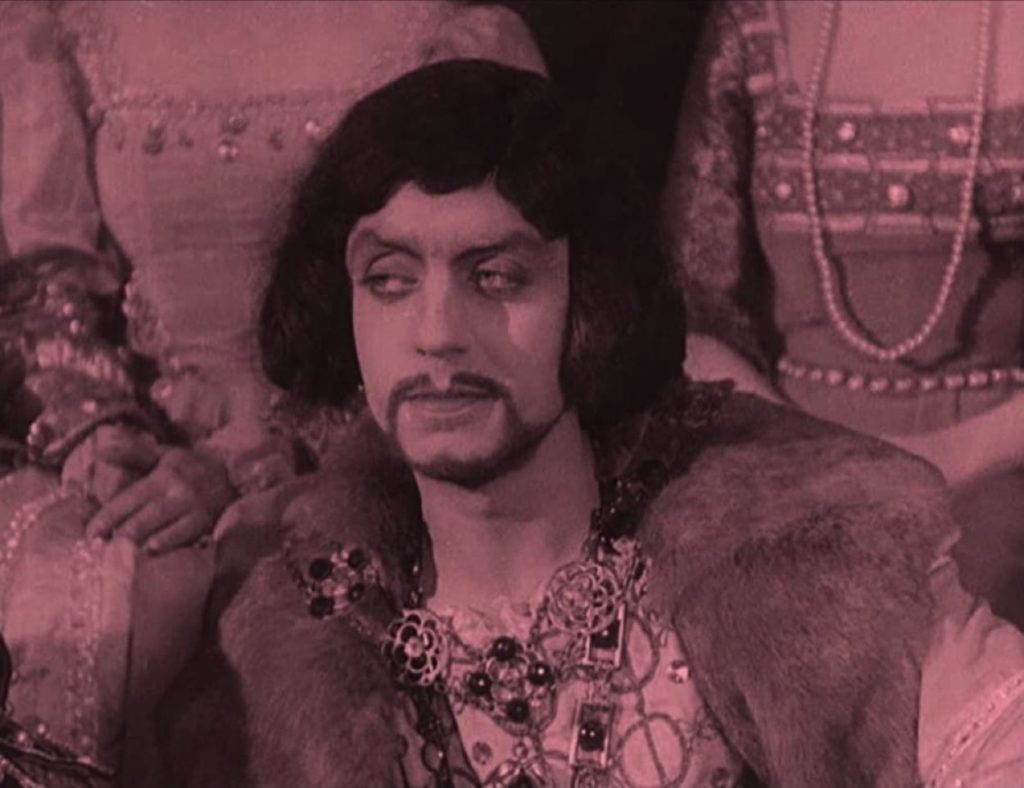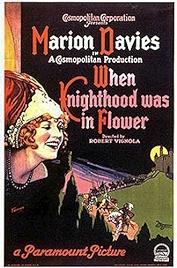When Knighthood Was in Flower answers the question posed by Citizen Kane – just how much of a chump was media magnate William Randolph Hearst over actress Marion Davies? Here is how much – a massive movie conceived on the grandest scale, produced by a company Hearst set up expressly to make Davies a star, with her name above the title, opening credits making great claims to the film’s historical accuracy, an opening scene with a grand entrance by Davies’s character in a royal barge, exteriors shot in Windsor, UK, even though much of the rest of the film was shot in New York and Connecticut, followed by an advertising campaign on the most gigantic of scales, backed up with all the critical fire-power that a newspaper magnate could muster, which was quite a bit. Hearst even had two pieces of music commissioned for the movie’s premiere, including The Marion Davies March.
Citizen Kane didn’t lampoon the relationship between Hearst and Davies directly, but its portrayal of an ageing media magnate infatuated with a talentless starlet was widely considered to be a reference to Hearst and Davies (something Orson Welles increasingly came to regret, but that’s another story). The two had been an item since 1918, when she was 21 and he 58, and When Knighthood Was in Flower was Hearst’s latest attempt to push Davies to the pinnacle of movie stardom.
Two things: it worked. By 1924 Davies was one of Hollywood’s biggest stars. Second, the movie: it’s good. Not excellent – it goes on a bit and could lose 20 minutes – but it is fine all-round entertainment offering something for everyone. Romance, intrigue, action, comedy, a race against time, tears and joy, massive, lavish sets, crowds of extras. All in all it’s high-calibre popcorn for 1922.
Like many other Hearst/Davies endeavours, it’s a historical drama, this time set in the 16th century at the court of Henry VIII and following Henry’s sister, Mary Tudor (not to be confused with his daughter, a later Mary Tudor) and her search for true love. In dynastic fashion she’s to be married off to one of Europe’s available royals, though the thoroughly modern Mary has other ideas – she’s espied sturdy guardsman Charles Brandon at a jousting tourney and is smitten.
The many twists and turns of the elaborate plot involve Henry (Lyn Harding) trying to get his sister (Davies) to obey his command, while Mary imploringly, beseechingly, coquettishly tries to persuade/charm the king into letting her marry Brandon. When that doesn’t work and she is forcibly married off to the doddery French king, Louis XII (a nice comedy turn by William Norris), she extracts a promise from her brother – for her second marriage she can choose whomsoever she pleases as a husband. It is a whomsoever kind of film.
Being silent, there is a fair bit of theatrical, back-of-hand-to-forehead acting going on, but Marion Davies only occasionally goes there. For the most part she puts in a subtle performance ahead of her time. She’s likeable, charming, forceful when necessary – we’re on this Mary’s side (the same can’t be said for her supposed true love, Brandon, a weedy presence in the form of Forrest Stanley).
For ease, the bad guys in this have facial hair. Brutish Henry VIII and the conniving Duke of Buckingham (Pedro de Cordoba) in England, while over in France a young William Powell (later the star of The Thin Man series) plays Louis’s heir, Francis, a prince in a hurry to bed Mary, married or not, willing or not. He’s a standout, clearly operating with much more understanding that cinema and theatre require very different approaches to acting.
In spite of the fact that director Robert G Vignola is using the static camera of the era, this is a film with plenty of pace, thanks in part to its brisk editing, its regular changes of set and the careful blocking work that Vignola has done with his actors. Ben Model’s work at the organ helps too, his soundtrack keeping the interest up without dipping into cliche.
The restoration, done in 2017, is good. Clearly this is an old movie, but it’s clean, the image is stable and flicker free, the odd scratch reminds us of its age, and the restoration has re-imposed the colour tinting of the original (it fades over time) and restores the hand-tinting in the final scenes, when a horse-chase sequence at night is enhanced by torches that flame yellow as the hooves thunder silently by.
Would Davies have been a big star without the help of Citizen Hearst? Who knows? It was a bit of a free-for-all still in those days. But she has what it takes and is in every scene of the movie and even gets a swordfighting scene disguised as a man. She’s versatile, and that’s exactly what When Knighthood Was in Flower needs.
When Knighthood Was in Flower – Watch it/buy it at Amazon
I am an Amazon affiliate
© Steve Morrissey 2022


